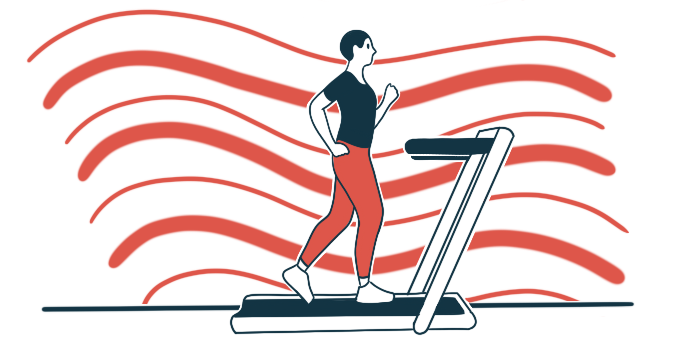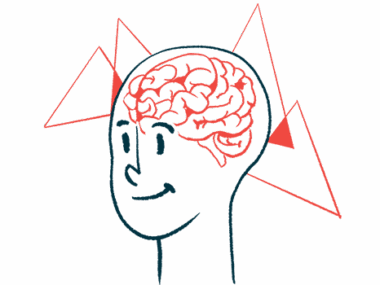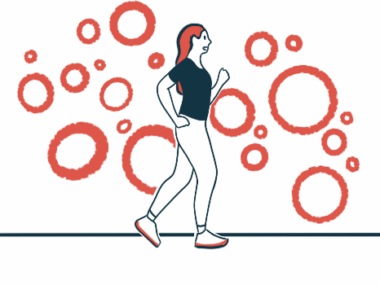Virtual reality game may help Parkinson’s patients in gait training
But improvements needed to make intervention more realistic, per study
Written by |

Combining gait training with virtual reality and gamification elements — when game-like features are added to non-game activities — may help people with Parkinson’s disease see rehabilitation as a positive experience, a study suggests.
That, in turn, could ultimately lead to better motor outcomes for patients, according to researchers.
While the initial results of this study show that such an approach offers a safe place to train gait, or a person’s manner of walking, in complex situations, the team noted that further improvements are needed to ensure that researchers can keep track of patients’ progress and make the training feel more realistic.
“This intervention was successfully shown as a feasible option for the training of gait under dual task conditions [such as clearing obstacles while walking] for” people with Parkinson’s, the researchers wrote. “However, further iterations of the intervention need to be improved in order to guarantee accurate tracking and a more realistic training progression.”
The study, “A gamified virtual environment intervention for gait rehabilitation in Parkinson’s Disease: co-creation and feasibility study,” was published in the Journal of NeuroEngineering and Rehabilitation.
Researchers add video game elements to virtual reality training
Earlier work has suggested that virtual reality, which uses computer-generated simulations to display a life-like environment that people can interact with in a game-style setting, may ease Parkinson’s motor symptoms and help patients regain cognitive skills.
Gamification, or using video game elements in other contexts to increase engagement, is also becoming popular in therapeutic exercise and training. By using elements like points, levels, and rewards, gamification is expected to make activities more engaging, leading to better outcomes.
Now, a team led by scientists at the University of Lleida, in Spain, combined gait training with both virtual reality and gamification to turn rehabilitation exercises on a treadmill into more engaging activities. Four people with Parkinson’s disease, who were enrolled in a clinical study (NCT05243394), took part in the intervention, alongside four physiotherapists.
The patients were three men and one woman with idiopathic Parkinson’s, in which the disease has no known cause, and a mean age of 61. While all had some computer experience, they had no to intermediate knowledge about virtual reality.
Two patients were classified as stage 2 in the Hoehn and Yahr scale, indicating motor symptoms on both sides of the body without impairment of balance. The other two were classified as stage 3, indicating motor symptoms on both sides of the body and mild to moderate disability with postural instability.
The participants were asked to walk on a treadmill in three virtual environments: countryside, city, and park. As they walked, the participants had to skip over obstacles like cones or bricks by lifting their feet. As difficulty increased, fog, darkness, distractions, and a narrower path with closer objects made avoiding obstacles harder.
Gamification elements, such as scoring, visual hints, progress bars, goal setting, and adjustable difficulty, were used to motivate participants. In the game, they walked a virtual dog while avoiding obstacles and progressing through different environments with the dog walking beside them.
Intervention scores well on usability with both patients and physiotherapists
To test how well patients and physiotherapists could use the setup, the team measured usability on the System Usability Scale, known as SUS, in which higher scores indicate better ease of use. The average SUS score was 74.82, indicating good usability, with patients giving a higher score than the physiotherapists (77.36 vs. 72.49).
The patients preferred the countryside environment over the city, finding it more realistic and pleasant. Specifically, they liked the presence of animals and sounds, although ravens were seen as “creepy or disturbing.” The dog was calming, according to the patients, with researchers noting that “its speed and distance from participants may be used as progress feedback as training advances.”
While patients found it difficult to navigate the obstacles due to the constant speed of the treadmill, a lack of visibility due to fog, or the obstacles’ size, the physiotherapists noted that patients moved the most affected lower limb to avoid obstacles, “which was positive for rehabilitation.”
The physiotherapists suggested randomizing obstacle sequences and adjusting heights for varying difficulty levels.
“Having them [the obstacles] appear at random instead of always in order would be nice,” one physiotherapist said.
More realistic scenarios, and more options for obstacles and surfaces to adjust training difficulty and progression, were other suggestions from the physiotherapists. They also suggested tracking distance and steps taken, and using a curved TV display for better immersion.
Another suggestion was to keep the tracker calibration’s information in each patient’s profile, with “a ‘save’ option for the tracker configuration, so you don’t have to calibrate them each time,” as noted by one physiotherapist.
This set-up is a strong option to help [people with Parkinson’s] better manage their difficulties in [dual-task] conditions in real life by training complex situations in a safe and replicable environment.
According to the researchers, the “overall experience was positive, and walking and obstacle dodging was fluid and precise most of the time.”
However, in suggesting a need for improvements, the team noted that “the tracking system had issues in some situations, mainly with intermittent losses of information, which caused the virtual feet to freeze.”
The software achieved a “Good” ranking on the SUS, the researchers noted.
“This set-up is a strong option to help [people with Parkinson’s] better manage their difficulties in [dual-task] conditions in real life by training complex situations in a safe and replicable environment,” they concluded.







